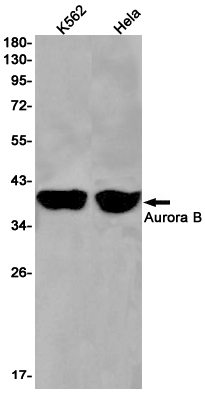
| WB | 咨询技术 | Human,Mouse,Rat |
| IF | 1/20 | Human,Mouse,Rat |
| IHC | 咨询技术 | Human,Mouse,Rat |
| ICC | 技术咨询 | Human,Mouse,Rat |
| FCM | 咨询技术 | Human,Mouse,Rat |
| Elisa | 咨询技术 | Human,Mouse,Rat |
| Aliases | AURKB; AIK2; AIM1; AIRK2; ARK2; STK1; STK12; STK5; Aurora kinase B; Aurora 1; Aurora- and IPL1-like midbody-associated protein 1; AIM-1; Aurora/IPL1-related kinase 2; ARK-2; Aurora-related kinase 2; STK-1; Serine/threonine-protein kinase 12 |
| Entrez GeneID | 9212 |
| WB Predicted band size | Calculated MW: 39 kDa; Observed MW: 39 kDa |
| Host/Isotype | Rabbit IgG |
| Antibody Type | Primary antibody |
| Storage | Store at 4°C short term. Aliquot and store at -20°C long term. Avoid freeze/thaw cycles. |
| Species Reactivity | Human |
| Immunogen | A synthetic peptide of human Aurora B |
| Formulation | Purified antibody in TBS with 0.05% sodium azide,0.05%BSA and 50% glycerol. |
+ +
以下是关于Aurora B抗体的3-4篇参考文献及其摘要:
1. **"Aurora B phosphorylates centromeric MCAK and mediates its displacement and degradation"**
- **作者**:Andrews, P.D. 等
- **摘要**:研究通过Aurora B抗体分析其在有丝分裂中的功能,发现Aurora B通过磷酸化MCAK调控微管动态和染色体排列,揭示其在纠正微管-着丝粒错误连接中的作用。
2. **"Inhibition of Aurora B kinase sensitizes cancer cells to cisplatin-induced apoptosis"**
- **作者**:Harrington, E.A. 等
- **摘要**:利用Aurora B抗体及小分子抑制剂,证明抑制Aurora B可增强癌细胞对顺铂的敏感性,机制涉及染色体错误分离和细胞周期检查点失效。
3. **"Aurora B couples chromosome alignment with anaphase by targeting BubR1. Mad2. and Cenp-E to kinetochores"**
- **作者**:Lens, S.M.A. 等
- **摘要**:通过免疫荧光和抗体阻断实验,揭示Aurora B通过调控BubR1等蛋白在动粒上的定位,确保染色体正确排列并调控后期起始的分子机制。
4. **"The small molecule Hesperadin reveals a role for Aurora B in correcting kinetochore-microtubule attachment and in maintaining the spindle assembly checkpoint"**
- **作者**:Hauf, S. 等
- **摘要**:结合Aurora B抗体与抑制剂Hesperadin,阐明Aurora B在纠正微管-动粒错误连接及维持纺锤体检查点中的双重功能,缺陷导致染色体不稳定性。
以上文献均围绕Aurora B激酶在细胞分裂中的核心功能展开,涵盖其分子机制及靶向治疗潜力。
Aurora B antibody is a critical tool in studying the Aurora B kinase, a serine/threonine-protein kinase central to mitosis and cell division. Aurora B, part of the chromosomal passenger complex (CPC), regulates key mitotic events such as chromosome alignment, spindle assembly, cytokinesis, and correction of microtubule-kinetochore attachment errors. Dysregulation of Aurora B is linked to genomic instability, aneuploidy, and cancer progression, making it a target for anticancer therapies.
Aurora B antibodies are widely used in research to detect and quantify Aurora B expression, localization, and activity in cells and tissues. They enable techniques like Western blotting, immunofluorescence, immunohistochemistry, and flow cytometry, aiding in the study of cell cycle dynamics, mitotic defects, and drug response. Specific antibodies may target distinct phosphorylation sites (e.g., Thr232. Ser331) or regions to assess activation states or interactions with binding partners.
These antibodies also have diagnostic applications, as Aurora B overexpression correlates with tumor aggressiveness and poor prognosis in cancers like breast, colorectal, and ovarian. Additionally, they are instrumental in validating Aurora B inhibitors in preclinical models. Researchers must select antibodies validated for species reactivity, post-translational modifications, and assay compatibility to ensure specificity and reproducibility. Commercial Aurora B antibodies are typically raised in hosts like rabbits or mice, with clones characterized for cross-reactivity and performance in diverse experimental systems.
×